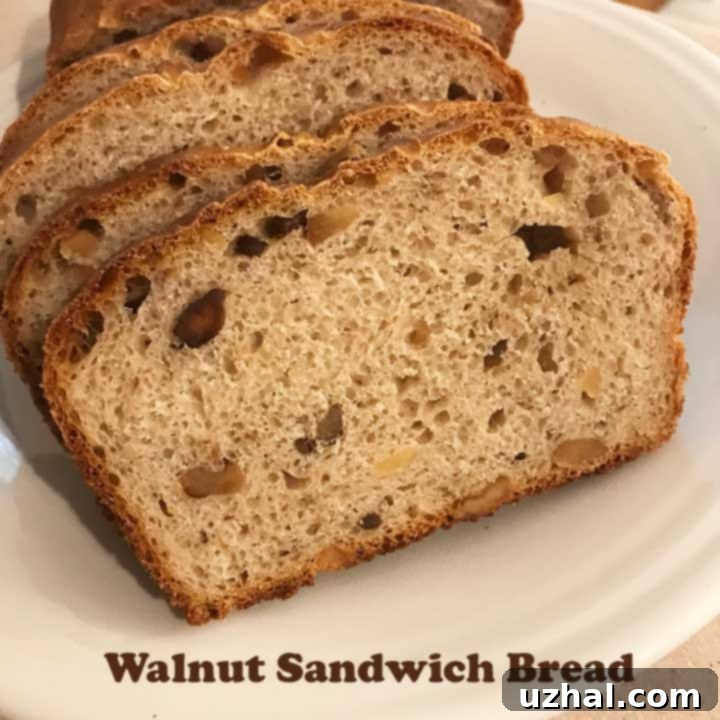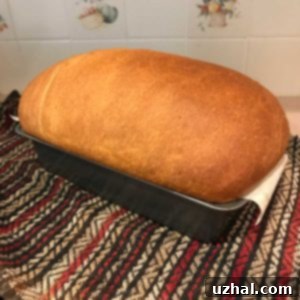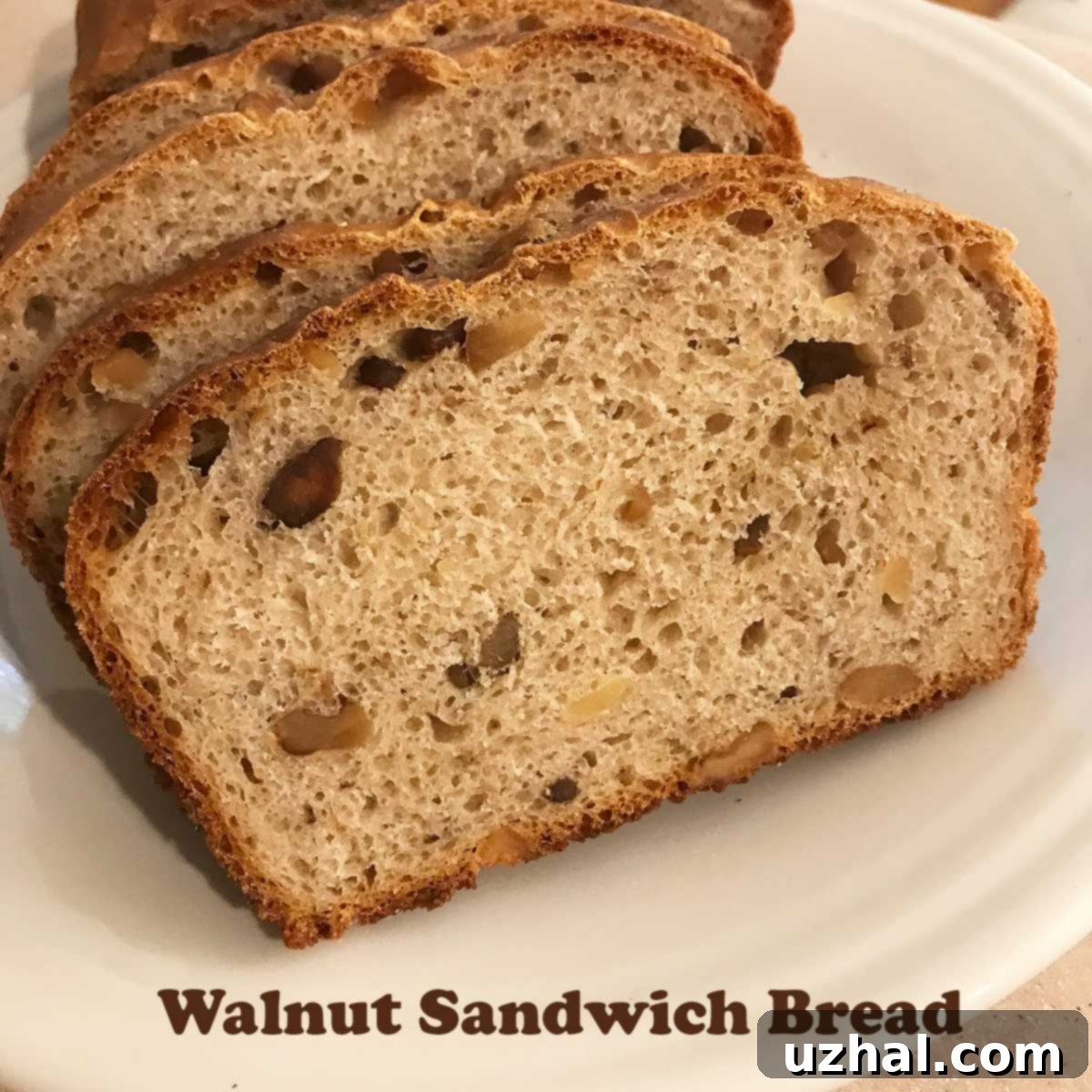Homemade Walnut Sandwich Bread: A Wholesome & Delicious Loaf for Every Meal
There’s nothing quite like the aroma and taste of freshly baked bread, and this Walnut Sandwich Bread recipe is a true testament to that joy. Inspired by a classic walnut bread recipe from Cooking Light, this version has been perfected over time to create a 9×5 inch loaf that’s ideal for everything from hearty sandwiches to comforting morning toast. It has become a beloved staple in my family, praised for its light texture and delightful walnut crunch.
While the original recipe cleverly incorporated rosemary, I’ve found that omitting it opens up a world of possibilities for this versatile bread. Without the specific herb flavor, it pairs beautifully with sweet spreads like peanut butter or jam, making it a perfect candidate for breakfast or a sweet snack. However, if you enjoy the aromatic hint of rosemary, feel free to add a tablespoon of fresh, finely chopped rosemary to the dough for an extra layer of complexity.

Why Bake Your Own Walnut Sandwich Bread?
In a world of readily available store-bought options, baking your own bread might seem like an extra step. However, the benefits of homemade bread, especially this Walnut Sandwich Bread, are immense. Firstly, the unparalleled freshness and flavor simply cannot be matched. Imagine waking up to the smell of warm, nutty bread filling your kitchen – it’s an experience that store-bought loaves can’t deliver.
Beyond the sensory delights, making your own bread gives you complete control over the ingredients. You can choose high-quality flour, fresh yeast, and premium walnuts, avoiding any preservatives or artificial additives often found in commercial breads. This makes it a healthier choice for your family, especially when you consider the nourishing power of walnuts.
This particular recipe yields a loaf with a perfectly balanced texture – soft and tender, yet sturdy enough to hold up to your favorite sandwich fillings. The chopped walnuts are not just for flavor; they add a wonderful textural contrast and a subtle richness that elevates every bite. It’s a versatile bread that adapts to sweet or savory applications, truly making it a kitchen essential.
Exploring Ingredient Options: Walnut Oil and Beyond
Experimentation is part of the joy of baking. I’m always looking for ways to enhance or adapt recipes, and this Walnut Sandwich Bread has been a canvas for some interesting tests. One idea I had was to replace the olive oil with walnut oil, hoping to intensify the nutty flavor throughout the loaf. I finally put this to the test, incorporating 1 tablespoon of my favorite walnut oil into the recipe.
Walnut Oil in Walnut Sandwich Bread Experiment
The result of using walnut oil was good, but honestly, not dramatically different enough to warrant going out of your way to purchase it specifically for this recipe. While it added a very subtle, nuanced nutty undertone, the difference was minimal compared to using good quality olive oil or melted butter. Both olive oil and butter provide excellent moisture and flavor, helping to create a tender crumb, and are generally more accessible. So, feel free to stick with what you have on hand; your loaf will be delicious either way.
Another area for future exploration, though not yet tested, is using hazelnuts in place of walnuts. Given their similar textural qualities and distinct, rich flavor, hazelnuts could offer a delightful twist, especially if toasted lightly before incorporating into the dough. I’ll be sure to update this post once I’ve had a chance to try it!
The Versatility of the Base Recipe: A Plain White Bread Option
Sometimes, simplicity is key. While the walnuts are undeniably the star of this recipe, the underlying bread dough is incredibly robust and flavorful on its own. If you’re looking for a reliable recipe for plain white sandwich bread, this one fits the bill perfectly.
Forget the Walnuts: A Simple White Bread Loaf
To make a delicious loaf of plain white bread, simply follow all the instructions as written, but omit the chopped walnuts. You’ll still end up with a wonderfully soft, elastic, and flavorful loaf that’s perfect for everyday use. This variation is fantastic for those who prefer their bread without nuts, or if you simply want a neutral canvas for a wider range of sandwich fillings and toppings.
It’s an excellent option for beginners looking to master a basic bread recipe before venturing into more complex variations. The smooth, even texture of the plain white loaf makes it an ideal choice for anything from grilled cheese to classic turkey sandwiches, or simply buttered toast.
Recipe: Walnut Sandwich Bread

Walnut Sandwich Bread
Pin Recipe
Ingredients
- 1 cup whole milk (between 105 and 110 degrees F – see notes for alternative yeast activation)
- 1 ½ tablespoons granulated sugar
- 1 packet active dry yeast (approx. 2 ¼ teaspoons)
- 2 ¾ cups bread flour (approx. 350 grams, plus more as needed for kneading)
- 1 teaspoon salt (plus a pinch for richer flavor)
- 1 tablespoon olive oil or melted butter (plus extra for greasing the bowl)
- 2 tablespoons lightly beaten egg (reserve remaining egg for brushing the top of the loaf)
- ½ cup chopped walnuts (lightly toasted for enhanced flavor)
- A little extra milk (for brushing the top before baking for a golden crust)
Instructions
-
In the bowl of a stand mixer, combine the warm milk (ensure it’s between 105-110°F to activate yeast without killing it), sugar, and active dry yeast. Stir gently until well combined. Allow this mixture to stand undisturbed for about 5 minutes. You should observe small bubbles forming on the surface, which indicates that the yeast is alive and active. Once bubbles appear, add 1 cup (approximately 115 grams) of the bread flour and stir thoroughly until a smooth, thin batter forms. Cover the bowl loosely with plastic wrap or a clean kitchen towel and let it rest in a warm place for 15 minutes. This step is crucial for developing flavor and giving the yeast a head start.
-
Now, add the salt, 1 tablespoon of olive oil or melted butter, 2 tablespoons of the lightly beaten egg (remember to reserve the rest for later), and 1 ½ cups (about 200 grams) of the remaining bread flour. Stir these ingredients together until just combined. Attach the dough hook to your stand mixer and begin kneading the dough on low speed. As the dough kneads, gradually add the remaining ¼ cup (around 25 grams) of flour, about 2 tablespoons at a time, until the dough starts to pull away cleanly from the sides of the bowl. Continue kneading for 8-10 minutes. The dough should become smooth, elastic, and soft to the touch, but not overly sticky. It should clear the sides of the bowl during kneading, but a slight stickiness to the very bottom is normal. Finally, add the lightly toasted chopped walnuts and knead for an additional minute or two until they are evenly distributed throughout the dough.
-
Lightly grease a large, clean mixing bowl with olive oil or butter. Transfer the kneaded dough to this bowl, turning it once to ensure it’s coated all over with the oil/butter. Cover the bowl tightly with plastic wrap or a damp kitchen towel. Place the bowl in a warm, draft-free spot (like a slightly warmed oven that’s turned off, or near a sunny window) and let the dough rise for 1 hour, or until it has visibly doubled in size. This first rise, known as bulk fermentation, is essential for developing the bread’s flavor and structure.
-
While the dough is undergoing its first rise, prepare your loaf pan. Thoroughly grease a 9×5 inch loaf pan with butter or cooking spray. For easier removal after baking, it’s highly recommended to line the bottom and two long sides of the pan with a strip of parchment paper, leaving an overhang on the sides. This creates “handles” to lift the finished loaf out.
-
Once the dough has doubled in size, gently punch it down to release the air. Transfer the dough to a lightly floured surface and briefly knead it a few times to reshape. Press the dough evenly into the prepared 9×5 inch loaf pan, ensuring it fills the corners. Lightly grease a piece of plastic wrap and loosely cover the loaf pan. Allow the dough to rise for a second time, for another 30 minutes, or until it has nearly doubled in size again and crowned slightly above the rim of the pan. This second rise, or proofing, gives the bread its final light and airy texture.
-
About 15 minutes before the end of the second rise, preheat your oven to 400°F (200°C). Once the oven is ready and the dough has completed its second rise, gently brush the top of the loaf with the reserved beaten egg or a little extra milk for a beautiful golden-brown crust. Carefully place the loaf pan with the risen dough into the preheated oven.
-
Immediately reduce the oven temperature to 375°F (190°C) after placing the bread inside. Bake for approximately 40 minutes. It’s a good idea to check on the bread around the 30-minute mark to ensure it’s browning evenly. If it’s browning too quickly, you can loosely tent it with aluminum foil. The bread is done when it’s deeply golden brown on top and sounds hollow when tapped on the bottom. For precise readiness, an internal temperature of 200-210°F (93-99°C) is ideal when measured with an instant-read thermometer. Once baked, remove the loaf from the oven and immediately transfer it from the pan to a wire rack to cool completely. Cooling on a rack is crucial to prevent the bottom from becoming soggy.
Notes
Tips for Baking a Perfect Loaf
Baking bread, while seemingly complex, becomes an incredibly rewarding experience with a few key tips:
- Yeast is Key: Always check your yeast. If it doesn’t bubble after 5 minutes in warm liquid and sugar, it’s likely expired or inactive, and your dough won’t rise. Start with fresh yeast.
- Dough Consistency: Don’t be afraid to adjust flour slightly during kneading. The goal is a dough that’s soft and elastic, clearing the sides of the bowl but still slightly sticky at the bottom. Too much flour makes dry, dense bread; too little makes it difficult to handle and can result in a flat loaf.
- Warm Environment for Rising: Yeast thrives in warmth. A slightly warm, draft-free spot (like a turned-off oven with the light on, or a warm pantry) is ideal for successful rising.
- Don’t Rush the Rise: Patience is a virtue in bread making. Let the dough take its time to double in size. A slow, steady rise develops better flavor and texture.
- Toasting Walnuts: Briefly toasting your walnuts before adding them to the dough significantly enhances their flavor and aroma, adding depth to the finished bread.
- Proper Cooling: Once baked, resist the urge to slice into the hot loaf immediately. Bread continues to cook as it cools, and cooling on a wire rack allows steam to escape, preventing a soggy bottom and ensuring a perfect texture throughout.
Serving Suggestions for Your Walnut Sandwich Bread
This Walnut Sandwich Bread is incredibly versatile and can be enjoyed in countless ways:
- Classic Sandwiches: Its sturdy yet soft crumb makes it perfect for turkey, ham, cheese, or even vegetarian sandwiches. The walnuts add a gourmet touch.
- Peanut Butter & Jelly (or your favorite nut butter): As mentioned, without rosemary, this bread is a fantastic companion for sweet spreads. The nutty flavor of the walnuts complements peanut butter beautifully.
- Avocado Toast: Elevate your avocado toast by starting with a slice of this walnut bread. The textures and flavors meld perfectly.
- Toasted with Butter & Jam: A simple yet satisfying breakfast or snack. The crunchy walnuts provide an extra layer of enjoyment.
- Cheese Board Companion: Slice it thin and serve alongside a selection of cheeses, fruits, and honey for an elegant appetizer.
- French Toast: For a decadent breakfast, use slightly stale slices of this bread to make a wonderfully rich and nutty French toast.
- Savory Pairings: Try it with a slice of sharp cheddar, a spread of cream cheese, or even a savory hummus.
Storing Your Homemade Bread
To keep your Walnut Sandwich Bread fresh for as long as possible:
- Cool Completely: Always ensure the bread is completely cool before storing it. Warm bread will create condensation, leading to sogginess and mold.
- Room Temperature: For optimal freshness within 2-3 days, store the loaf in an airtight bread box or a clean plastic bag at room temperature.
- Freezing for Longer Storage: This bread freezes beautifully. Once completely cool, slice the loaf and place the slices in a freezer-safe bag. Remove as much air as possible before sealing. Frozen slices can be toasted directly from the freezer, offering fresh bread on demand for up to 2-3 months.
Embrace the Joy of Homemade Baking
Baking bread at home is a wonderfully satisfying endeavor, and this Walnut Sandwich Bread recipe is a fantastic way to bring warmth, comfort, and incredible flavor into your kitchen. Whether you’re an experienced baker or just starting your journey, the process of mixing, kneading, and watching the dough transform into a golden, aromatic loaf is truly magical. Enjoy the journey, savor the delicious results, and share the joy of homemade bread with your loved ones!
- Lemon Filled Sandwich Cookies
- Coconut Milk Sandwich Bread
- Chocolate Banana Ice Cream Sandwiches
- White Sandwich Bread
- Chocolate Sandwich Cookies
